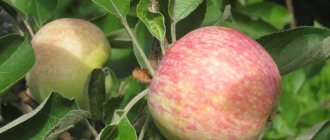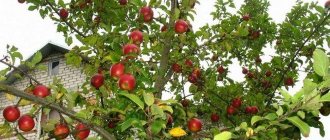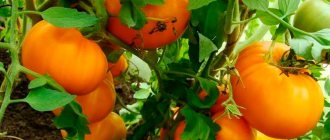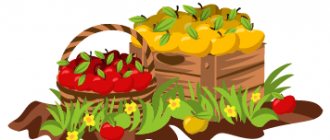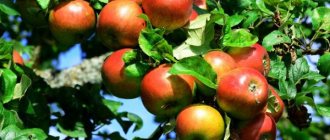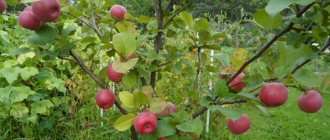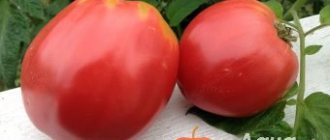Apple trees are popular in industrial and amateur gardens .
Gardeners strive to obtain high yields while investing less money and labor effort.
Developments of domestic breeders allow us to choose the best modern varieties of apple trees for this :
- Zoned , intended for cultivation in certain climatic conditions;
- Easily adapt to the characteristics of soil , topography, humidity and seasonal temperatures;
- Resistant to specific diseases and pests;
- Long-lived and high-yielding;
- With large, shelf-stable marketable fruits.
These are the qualities that the apple tree variety Yablochny Spas has.
It is perfect for a future garden , rich in harvests and not requiring labor-intensive care.
Description
Apple tree Apple tree is the pride of modern selection . Bred in 2004 by specialists of the All-Russian Research Institute for Breeding Fruit Crops (Orel), registered by the State Register in 2009.
Obtained by polyploidy . Apple trees usually have 2 sets of chromosomes, one each from the mother and father plants.
Varieties with three and four such sets have been obtained by artificial crossing.
Triploid varieties produce the largest number of large, juicy marketable fruits . This is exactly what the apple tree of the Yablochny Spas variety is like.
The variety is summer, the fruits are not intended for long-term storage .
IMPORTANT! The Apple Spas variety is absolutely not susceptible to scab and is resistant to a range of fungal and bacterial diseases and pest attacks.
Frost-resistant, adapts well to soil and climate characteristics . Therefore, excellent results are shown not only in the regions of central Russia for which it is zoned, but in the Ural and Siberian gardens:
- Large tree,
- With a rounded crown,
- The branches are curved and spread spaciously along the trunk, forming almost right angles with it.
- The pointed leaf is matte, dark green, with a wavy edge.
- The flowers are large, with pink petals.
The apples are larger than other varieties , weighing at least 200g. Round, strongly ribbed, light yellow with a soft green tint. Partially covered with vertical dense and intermittent stripes of scarlet to crimson colors. Ripe fruits look very elegant.
What to do if it doesn’t bloom or bear fruit
When growing an apple tree in a summer cottage, you may encounter some difficulties due to the fact that the tree may not bloom or bear fruit.
The following factors may be the reasons:
- Incorrect landing. It is not recommended to deepen the root collar, as this inhibits the development of seedlings. As a result, they may dry out. Fruiting may not occur if the tree was planted on the north side, in a shady area or in a draft. The liquid should not rise 2 m above the soil level. In order for flowering and fruiting to occur, it is permissible to replant the plant, add fertilizer to the soil, or drain excess water into a drainage ditch.
- Incorrect crown formation. If you make a mistake in formation, there will be no apples on the tree or they will be very small. The huge volume of branches creates density. The tree has to spend too much energy, which will not be enough for the development of fruits. Therefore, once a year it is necessary to remove old, weak branches and vertically growing shoots.
- Difficulties with pollination. In order for a tree to produce ovaries, it requires cross-pollination. Therefore, several trees should bloom near the apple tree.
- A huge volume of buds. Due to the large number of buds, the apple tree will not have time to develop an ovary from them. Therefore, most of the flowers will simply fall off. To regulate the volume of the ovaries, it is necessary to leave the central branches and cut off the side ones.
- Excess or deficiency of fertilizers. If too much fertilizer was applied to the soil layer at the beginning of the autumn period, the tree will shed its buds in the spring season.
- Spring frosts. If the ovaries are subject to early spring frosts, the buds will fall off. To protect the tree from sudden temperature changes, you can apply smoke or sprinkler.
- Pest invasion. A tree may not bloom if there are insects on it that destroy the buds. To eliminate pests on the bark, you need to stick on hunting belts and treat the apple tree with insecticides. The last procedure must be carried out before flowering begins. If the crop has bloomed, it is not recommended to use chemicals, since they can kill not only harmful, but also beneficial insects.
The apple tree variety Apple Spas, based on the description and photo, is a resistant crop that can withstand severe frosts and resist various diseases. The fruit tree is unpretentious in care and can produce a harvest for 3 years after planting the seedlings.
additional characteristics
Apple tree Apple saved.
Peculiarities
Among the characteristics of the variety are::
- Immunity to scab;
- Precociousness;
- High adaptability to climate and soil;
- Frost resistance;
- Stable yield.
Tree height
An adult specimen of Spas can reach a height of 10 - 15 m.
Pruning should be done in a timely manner.
Maintaining a height convenient for the gardener is necessary for:
- Picking fruits
- High-quality pruning,
- Wood processing.
The optimal height is 6-7 m.
Crown width
- The branches of the apple tree spread over a length of up to 2 m.
- The crown in this case has a diameter of 4 m.
In Apple Spas it is medium thick and round in shape.
Annual growth
The annual growth of a fast-growing young tree reaches 40–60 cm. Higher growth may indicate excess fertilizer and moisture.
Such shoots do not ripen and do not tolerate frost well. In mid-summer you need to pinch these branches and twist them under the lower ones, reduce watering.
Productivity
Early fruiting variety:
- The first apples are harvested in the second or third year after planting.
- In subsequent seasons, the yield increases and by the seventh year reaches 40–50 kg per tree or 145 centners per hectare.
- Each apple tree bears fruit annually and abundantly; this is one of the distinctive features of the variety.
Tasting assessment
The apples are large, juicy, with light, slightly greenish flesh, pleasant structure, crispy, and medium hard.
These properties do not change over time.
The taste is rich, sweet and sour or sweet , the aroma is subtle, apple.
Experts rate the taste of the variety at 4.3 points out of 5 .
ADVICE! Summer apples are eaten fresh and added to baked goods and desserts. Juices, preserves, and jams are prepared from them.
Winter hardiness
The Apple Spas variety tolerates winter well and is not afraid of 25-degree frosts .
In rare cases, reversible cold damage to the buds and bark has been observed, which does not affect fruiting and yield.
During the tests, Spas received 0 points on the damage scale after wintering in favorable conditions, and 1.5 - when they worsened.
Due to their good winter hardiness, apple trees are planted in gardens in Siberia and the Urals.
Disease resistance
Absolute resistance to all known types of scab and excellent resistance to damage by other diseases and pests are the main advantages of the variety .
Gardeners appreciated the reduction in the labor intensity of caring for apple trees, because they do not need to be treated with insecticides and fungicides .
Chemical contamination of fruits and the natural environment is reduced.
Apple tree variety Apple saved.
Lifespan of a tree
Breeders and agronomists highly appreciate the prospects of this new apple tree .
They believe that under favorable conditions and proper care, each tree can produce abundant harvests for up to 70 years .
Advantages and disadvantages
In reviews of the Apple Spas apple tree, experts and gardeners agree and praise its many advantages:
- immunity to scab, increased resistance to common diseases and pests of fruit trees. Thanks to this, caring for the apple tree becomes less labor-intensive and costly, and chemical contamination of the fruit is reduced;
- regular, abundant harvests;
- precociousness;
- excellent winter hardiness;
- high marketability of fruits;
- adaptability to the soil and climatic characteristics of the growing region.
Early ripening times delight all lovers of summer apples
The only relative disadvantages of the variety are the large dimensions of the trees and the short shelf life of the fruits.
The Oryol triploid varieties also include the Rozhdestvenskoye apple tree. You can learn more about it from the article on our website.
Reviews
The variety was recently developed and is just beginning to gain recognition among gardeners.
Those who managed to get the first harvest share the results and these impressions:
Stepan: You need to plant it in your garden ! Friends and acquaintances gasp - the apples are beautiful, clean, big. The taste is sweet and sour. The aroma is not strong.
Svetlana: 2 years have passed since the purchased seedling was planted. We bought it after seeing the description and photo. The first 5 apples were removed. Very large, impossible to eat in one sitting ! To my taste, they are very pleasant. Sweet, but without cloying, there is sourness.
A beautiful apple tree with delicious fruits.
Easy to bite, medium fluffy flesh. Juicy, but without excess. There is nothing unusual in the aroma, just a pleasant apple scent. Very beautiful! I recommend!
Igor: The apples are fully ripe for Apple Saving ! And this is in a cool summer! Strong, very large, the flesh is loose and juicy! And how fragrant!
Ekaterina: The first harvest of the Savior has been collected! The taste is incomparable ! Sweet – sour and juicy. We survived 2 winters perfectly! For homestead farming - just what you need! Fully corresponds to what was seen in the photo and description of the variety before purchase.
Preparing for winter
Apple tree Apple tree (description of the variety, photos will explain to gardeners how to prepare a fruit tree for winter) when the temperature decreases to more than -15 ℃, it requires shelter, especially for young seedlings.
The tree trunk should be covered with warm material that can allow liquid and air to pass through. For older specimens at temperatures below – 25 ℃, similar measures should also be taken.
Features of planting and care
Landing
Deadlines
Seedlings are planted in autumn or early spring after the snow melts. In this case, the soil should thaw to a depth below the roots.
ATTENTION! Autumn plantings take root better, and the percentage of those that survive the winter is higher.
Technology
For planting, choose a well-lit and protected from the wind place:
- The pit is prepared in 2–6 weeks , the diameter and depth are at least 1 m.
- Phosphorus and potassium fertilizers , peat, humus and rotted manure to it
- A seedling is placed on top, straightening the roots, and covered with soil.
- At the same time, a peg is placed next to the tree, to which it is then tied.
- The soil around is carefully crushed, a circle near the trunk is formed, and the planting is watered abundantly.
Growing
When cultivating apple trees, you should take into account the characteristics of the variety :
- For better pollination and increased productivity, you need to place 2-3 diploid trees on the site ;
- Annually prune rapidly growing shoots, but do not get carried away with strong shortening, this can reduce the yield;
- Cold damage to the bark is usually insignificant, but in case of serious damage, you need to cover the cracks with garden varnish in the spring.
Agricultural technology
Standard agrotechnical practices for apple trees are used:
- Timely pruning
- Fertilizing with mineral and organic fertilizers,
- Watering.
- Loosening and mulching the tree trunk circle.
Due to its characteristics, Apple Saved is less in need of protection from pests and diseases.
Pruning and crown formation
Form a rounded crown.
In the spring, before the buds swell, formative and sanitary pruning is performed.
Remove:
- Broken, damaged, weak and diseased branches;
- Branches growing parallel to the trunk and inside the crown;
- Weak and thickened shoots.
Pollinator varieties
Apple tree variety Apple saved.
Apple Spas is a self-fertile variety, but not self-pollinating .
In order to obtain consistently high yields, you need to have 2 - 3 diploid trees in the garden. These are the most common traditional apple trees in amateur gardens.
Features of growing Apple Spas
Landing
Basic conditions
- To plant the variety, you need to select only well-lit, open spaces with high-quality ventilation. However, you need to make sure that there are no drafts; trees do not like this and may begin to get sick or even not bear fruit.
- Spas is not picky about soils; it can grow equally well in sandy loam, loam or black soil. You just need to monitor the acidity, like all apple trees, this one prefers slightly acidic soils.
- You should not plant trees in wetlands, in close proximity to open bodies of water, or where water constantly stagnates; this can lead to the development of diseases and rotting of the roots.
- The pits for planting are prepared in advance, 4-6 weeks, but it is better in the fall. To do this, dig holes 1 meter deep and the same in diameter, mix the top layer with fertilizers, fill it back up, fill it with 40-50 liters of water, and leave it in the open air. It is better to leave a distance of at least 5-6 meters between trees in a row, and 4-5 meters between the rows themselves (for dwarf and semi-dwarf rootstocks this can be reduced).
- Drainage made of gravel, vermiculite or broken brick is laid at the bottom of the pit. A layer of 10-15 centimeters is enough. A stake is immediately driven in to secure the tree, which can only be removed for 4-5 years.
- The tree is placed vertically, with its roots straightened, sprinkled with earth, compacted tightly with hands, watered with 40-50 liters of water, and the surface is mulched with a suitable material (manure, chopped grass, compost).
Disembarkation dates
You can plant Apple Saved both in the spring, almost immediately after the snow melts, as soon as the soil warms up to the level of the roots, and in the fall, when the leaf fall ends and the movement of sap in the trunks stops. Experienced gardeners still advise choosing autumn plantings, since the survival rate of trees is then much higher. Seedlings with a closed root system (in special bags or pots that do not require disposal) can be planted throughout the entire growing season.
Protection from frost and rodents
In a mild continental climate, it is enough to simply cover the trunk area to protect the trees from frostbite. It is covered with spruce branches, sheaves of straw or hay, the trunks are wrapped with roofing felt, roofing felt, burlap or agrofibre. In the first years, seedlings on a seed rootstock or dwarfs up to 4-5 years old can be covered using the tent method.
To prevent hungry rodents from coming to feast on the young and tender bark in the winter, in the fall it is lubricated with grease or rendered lard. The threat can be insects that remain for the winter at the roots of the tree. Therefore, trunks should be whitened with lime to drive them away, preventing damage to foliage, fruits and wood in the future.
Tree care
Loosening the soil, watering: proper agricultural technology
The tree only needs regular loosening of the soil for the first few years, until it finally takes root and grows. However, it won’t hurt to dig up the near-trunk area in the future. At the same time, you need to remove root shoots, weeds, grass, and shoots of other trees and shrubs.
Watering trees of this variety is not necessary, especially in adulthood. Young trees can be watered approximately twice a month in dry and hot weather. 20-30 liters per apple tree will be enough, distributing watering twice (morning and evening). Adult specimens will require less frequent application of moisture, but greater quantities. You will need up to 50-60 liters, 4-5 times a season. Watering can be timed to coincide with the period of ovary formation, flowering and fruit ripening.
Pruning: simple crown formation
For this tree, the most acceptable crown shape will be round, sparsely tiered, so it is worth forming it. In the first year after planting, the central conductor is shortened by a third, and side shoots, if present, are made shorter than it in tiers. The procedure will have to be repeated every year, and you must not miss the moment, because the tree is actively gaining height.
Sanitary pruning is required for Apple Rescue. With it, you need to immediately cut off all damaged, dry or diseased branches. It wouldn’t hurt to regularly carry out rejuvenation after 15-20 years. To do this, you need to saw off 2-3 age shoots per year, this will allow the young ones to develop and begin to bear fruit.
Pollinator varieties
- Quinty.
- Juliered.
- Delicious golden.
- Delcorf.
- Idared.
- Gala.
Reproduction
- Clones (layers).
- Grafting with cuttings or buds.
- Rooting cuttings.
- Growing from seeds.
Diseases and pests
- Bacterial burn.
- Black cancer.
- Green aphid.
- Codling moth.
- Leaf roller.
- Flower beetle
Features of ripening and fruiting
Beginning of fruiting
Typically, apple trees begin to bear fruit at 5–6 years of age .
The difference between Apple Rescue is that the first apples appear in the third summer. Such varieties are called early-fruiting.
Deadlines
Fruit ripening
The fruits ripen on average from 8–10 to 17–18 August .
These dates determine the name of the variety - after the name of the Orthodox holiday Apple Savior, which is celebrated on August 19.
Fruit storage
Summer variety , intended for consumption immediately after ripeness.
After picking, the fruits are stored for 1 – 1.5 months.
Productivity
The trees produce good harvests relatively early, so Yablochny Spas is classified as a fast-growing variety.
Productivity increases with the age of the tree.
From apple trees over 7 years , you can collect an average of more than 45-50 kg of fruit.
Harvest dates depend on the region, but generally it is the second ten days of August.
Read about high-yielding varieties of apple trees: Antonovka dessert, Gala, Grushovka winter, Lyubava, Kuibyshevskoye, Daughter of Pepinchik.
Options on dwarf and semi-dwarf rootstocks
Specialists from the Research Institute for Breeding Fruit Crops conducted experiments on growing Apple Spas on dwarf and semi-dwarf rootstocks.
The variety showed better results compared to other triploid summer apple trees.
Prototypes:
- Formed a good root system,
- They bravely endured frosty winters with little snow.
- The height of the trees is significantly lower than that characteristic of the variety. This simplifies plant care and harvesting.
- The first fruits were obtained later and in scarcer quantities than in the tall form. But after three years, breeders recorded a yield of more than 60 centners per hectare.
Advice! Growing an apple tree on a dwarf rootstock allows you to place a larger number of plants on the site, increase productivity and provide high-quality care for the entire crown.
Agricultural technology
The temperate climate of the tolerance regions allows you to plant Apple Spas in spring or autumn. Be careful when choosing a site, as the crop has a long productive life span. For planting, try to select flat, well-lit places with low groundwater (about 2.0 meters to the surface). The apple tree does not like too acidic soil and heavy clay soils. Loose and nutritious loams, chernozems, sandstones, gray soils, and chestnut soils are suitable for it. Seedlings must be provided with regular watering. Mature trees are watered less frequently, but more abundantly. In the spring, nitrogen-containing fertilizers are used to help the tree increase its vegetative mass. At the beginning of flowering, potassium supplements are added to the diet. Closer to autumn, superphosphate is used, which will help the plant prepare for winter. An important stage of care is the formation of the crown and maintaining the height of the tree at a level not exceeding 7.0 meters, otherwise it will be difficult to perform pruning, preventive treatments and harvesting.
Apple saved is a new word in breeding. This promising variety is of great value for introduction into production, as it meets the basic requirements of an intensive adaptive garden. But this new product will not disappoint the ordinary gardener. The culture combines almost all the main characteristics that, according to the gardener, an ideal apple tree should have. The variety is distinguished by its stability and productivity. The fruits have high commercial quality; a rare summer variety can boast large apples. Good frost resistance and the ability to quickly recover in case of freezing allow the plant to be grown in cool regions. This is also facilitated by high resistance to scab, which reduces winter hardiness. During the time of growing and observing our hero, no significant flaws were discovered. Perhaps only high growth can add trouble to the gardener, but this problem can be easily eliminated and kept under control with the help of pruning.
Growing in regions
The Yablonevy Spas variety is included (zoned) in the State Register of Breeding Achievements in the Central and Central Black Earth regions .
This means that here are the best climatic conditions for cultivating apple trees.
These groups include the Moscow region and regions of central Russia.
Cultivation of Spas does not have distinct regional characteristics.
You just need to take into account the microclimate of a specific area and area:
- So, apple trees will not do well on land with high groundwater,
- In vast open spaces with cold winds,
- In places with constantly low temperatures.
In the Urals, the apple also took root. Here gardeners insulate the trunk for the winter by wrapping it with spruce branches and rags. The ripening dates have been shifted to early September.
Apple tree lovers from the Yaroslavl region also note the need for additional protection of apple trees from winds and frosts.
Diseases and pests
The Apple Saved variety is not afraid of scab. It also has excellent resistance to other diseases and pests. If dangerous insects appear in the garden, including only on other crops, treatment with the following preparations is recommended:
- Aktara;
- Karate;
- Biotlin;
- Decis Profi (Expert);
- Calypso;
- Match;
- Speed;
- Luna Tranquility;
- Fufanon;
- Fitoverm.
To prevent diseases and pests, it is important to regularly weed the tree trunk, prune, follow a watering schedule, and remove fallen leaves and fruits. It is necessary to systematically treat other crops in the garden that do not have such immunity.
How to store apples?
Summer fruits do not like temperature fluctuations and dampness. They should be stored in a well-ventilated, dry and cool place. The ideal ambient temperature is 0-40C.
After harvesting, it is necessary to sort the fruits, selecting spoiled ones. For storage it is better to use containers knocked down from boards. The fruits can also be placed in plastic or cardboard boxes. In this state they can be stored for more than 6 months.
The negative side of this variety is the need to sort the fruits several times during the winter. Soft or rotten apples must be removed promptly.
Culinary experts love this variety for its pleasant aroma and taste. Cider, juice, jams, preserves, and sauces are made from these apples.
Similar varieties
Hybrid Apple Spas has similar characteristics to other varieties, sometimes this is explained by common parents:
- Maslovskoye is a summer hybrid with scab resistance obtained from the same parents (crossed Red Free and Papirovka tetraploid), tall trees with a rounded crown, wide-ribbed fruits of 230 g, greenish-yellow color with a pinkish speckled cover on the side.
- Avangard is a triploid summer hybrid with fruits larger than average, the color is greenish-yellow with a blurred blush, the taste is excellent, sweet and sour.
- Orlinka - large trees, medium-sized fruits with a sweet and sour taste and pleasant aroma, the variety is resistant to scab, high-yielding, early fruiting.
- Lungwort is a high-yielding hybrid with immunity to scab, medium-sized yellow-green apples, up to 50% of the color is occupied by the outer scarlet, excellent taste (the fruits can be consumed even before they are fully ripe).
- Orlovim is a summer variety of medium-sized apple trees with medium-sized, slightly ribbed fruits, very juicy pulp with a sweet and sour taste and pronounced aroma, the hybrid is resistant to scab, is early-bearing and high-yielding.
Apple tree Spasskoe
Apple tree Spasskoe.
Scab immune, triploid, summer variety. Crossing (Redfree x Papirovka tetraploid) was carried out at SK3NIISiV in 1989, other work was carried out at VNIISPK. Sowing of seeds was carried out in 1990, selection in a selection school in 1991, planting in the garden in 1992, budding into the crown of the skeleton 3-4-98 in 1999. Elite since 2003. Authors: E. N. Sedov, Z. M. Serova, L. I. Dutova, V. V. Zhdanov, G. A. Sedysheva, E. A. Dolmatov, T. V. Ragulina, M. A. Makarkina. In 2009, the variety was accepted for state testing.
The trees are medium-sized (height 2.5 m, crown diameter 2.0 x 2.2 m) with a rounded crown of medium density. The main branches are curved, extending from the trunk at an angle close to a straight line, the ends of the branches are directed upward. The bark on the trunk and main branches is smooth and greenish. The fusion of the scion with the rootstock is good. The shoots are of medium thickness, arched, round in cross-section, brown, slightly pubescent. Lentils are numerous and small. The buds are medium in size, appressed, conical, pubescent. The predominant type of fruit formations are simple and complex ringlets. The leaves are large, oblong, ovate, short-pointed with a helical twisted apex, green, with a yellowish tint, wrinkled, shiny, with rough nerves. The leaf blade is concave, curved downwards, and slightly pubescent. The edge of the leaf is serrate-crenenate. The petiole is long, thick, pubescent, with anthocyanin coloring, extending to the central vein. Flower buds are pubescent, medium-sized, lanceolate. The flowers are large, pinkish. The petals are oval.
The fruits are above average size (170 g). Average height 67 mm, width 73 mm. The one-dimensionality of the fruits is average. The shape of the fruit is oblong-conical, wide-ribbed. The skin of the fruit is of medium thickness, smooth, dry, dull, without a waxy coating. The main color is green, the outer color on a smaller part of the surface of the fruit is in the form of stripes and specks of red. Subcutaneous dots are numerous, large, green, and clearly visible. The peduncle is straight, obliquely set, of medium length. The funnel is of medium depth, pointed, narrow. Rusty gray. The saucer is small, wide, grooved. The calyx is closed. The heart is bulbous. The seed chambers are semi-open, of medium size, and do not communicate with the axial cavity. The seeds are small, underdeveloped, ovoid, brown. The subcupal tube is cauldron-shaped and of medium length.
The pulp of the fruit is greenish, dense, juicy, sweet and sour. Taste qualities are rated at 4.3-4.4 points, fruit attractiveness - at 4.4 points. The chemical composition is as follows: sum of sugars - 11.9%, titratable acids - 0.67%, ascorbic acid - 12.4 mg/100 g, vitamin P - 366.2 mg/100 g. Fruit ripeness occurs in the Oryol region 10 -August 12, the consumer period lasts until the second ten days of September.
The variety is productive. On average, over the last 4 years, the yield of regrafted trees was 15.0 t/ha, while the control variety Melba over the same years produced a yield of 9.0 t/ha. The variety is quite winter-hardy for the Oryol region.
Advantages of the variety: immunity to scab, high marketability and attractiveness of fruits, high yield.
Source of the article: https://xn--13-6kcue7bya8b6b.xn--p1ai/sazhentcy/yablonya-sazhentcy/letnie-sorta-yabloni/yablonya-spasskoe

